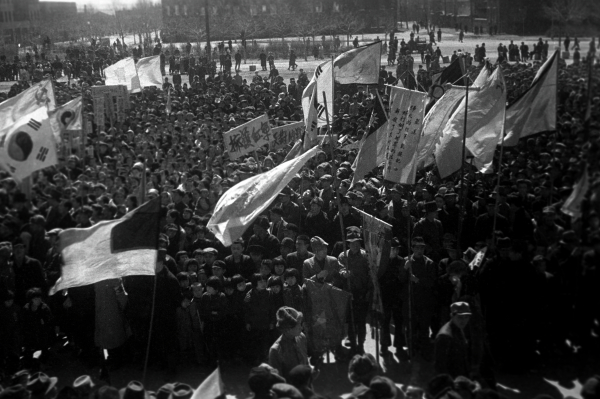Road to Victory: Ending 35 Years of Occupation

The 35-year-long Japanese colonial rule over the Korean Peninsula came to an end with the conclusion of World War II. For 80 years, Koreans have been marking National Liberation Day. Read this RIA Novosti article to learn how the Korean nation won its independence and the role the USSR played in this process.
Fighting for sovereignty
The decision by the Japanese government to reinforce its positions on the Korean Peninsula dates back to the early 20th century when, in July 1905, the country’s Prime Minister Katsura Taro and United States Secretary of War William Howard Taft signed an agreement setting forth their vision of the role their countries aspired to in Greater East Asia following Japan’s victory in the Russo-Japanese War. Under this deal, the United States promised to refrain from interfering in Japan’s policy towards Korea.
On November 17, 1905, the Japanese and Korean empires signed a treaty to establish a protectorate. This move displeased the Korean population, resulting in the emergence of a resistance movement which sought to restore national independence and preserve the country’s cultural heritage.
“The anti-Japanese resistance movement started in Korea soon after the country signed the treaty with Japan creating a protectorate in November 1905. The so-called Righteous Armies started forming across the country, mostly consisting of peasants led by the local nobility,” Natalya Kim, Director at Moscow State University’s International Center for Korean Studies, said.
In 1910, the Japanese Empire officially annexed Korea with a Japanese resident-general acting as the de facto ruler.
“The Righteous Armies continued to plead their cause even after the Japan–Korea Annexation Treaty was signed in August 1910, but the Japanese colonial authorities crushed this resistance in 1910 and 1911. This is why Korea’s national liberation movement moved abroad at this point, taking root in Russia’s (Soviet) Far East, as well as in Manchuria and the United States,” Natalya Kim pointed out.
The long road to victory
In March 1919, Koreans staged a mass uprising demanding the restoration of national sovereignty, only to face another defeat. According to Korean historians, up to three million people took part in the uprising.
“Several Korean governments were formed during the uprising in Soviet Russia and China, all claiming to be the legitimate representatives of the Korean people abroad. They eventually united to form a single government, known as the Provisional Government of the Republic of Korea. It operated from Shanghai, which remained its capital-in-exile for a considerable time,” Natalya Kim noted.
On September 27, 1940, Germany, Italy and Japan signed the Tripartite Pact in an effort to delineate their respective spheres of influence in what they believed to be a nascent new order. This is how Berlin, Rome, and Tokyo formed the military and political bloc known as the Axis Powers.
The Second World War ended in Europe in May 1945 with Germany’s defeat, but Japan refused to surrender. Apart from Korea, it occupied Indochina, Indonesia, Malaya, part of China, Burma and the Philippines in the Asia-Pacific region.
By that time, the United States and the United Kingdom had been at war with Japan for over three years and were making some advances, but victory remained beyond their reach.
The August storm
On August 8, 1945, the Soviet Union officially declared war against Japan and confronted the Kwantung Army the following day.
“By joining the Allies in their war against Japan, the USSR sought to eliminate the second-biggest hotbed of war, this time in the Far East, by dismantling the aggressive Japanese Imperial Army, which threatened Soviet borders in that region, while also offering China, Korea and other Asian nations its brotherly international assistance in overcoming the oppressive rule by the Japanese colonizers,” Head of the Center of Korean History and Culture at the Russian Academy of Sciences Oriental Studies Institute, Bella Pak, said.
She went on to say that Soviet troops from the 1st Far East Front’s 25th Army took part in liberating the Korean Peninsula together with the Pacific Fleet’s marines.
In fact, these naval infantry units mounted a rapid attack, capturing one Korean port after another under their control, making it increasingly difficult for Japan to evacuate its troops and assets from Korea.
Friendly treatment
On August 15, just one week after the Soviet Union entered the war against Japan, the Japanese Emperor addressed his nation in a radio message, urging people to stop resisting. On the same day, the 1st Supreme Commander for the Allied Powers in the Pacific Ocean, General Douglas MacArthur, drafted General Order No. 1. Under this document, the Japanese troops north of the 38th parallel in Korea were to surrender to the Soviet command, while those stationed south of this latitude were to surrender to the United States.
Despite the capitulation, local hostilities on the peninsula continued for several days.
“The Koreans had a very friendly attitude toward the Soviet Army. Reports from frontline journalists of the Izvestiya newspaper documented the first encounters between Korean and Soviet soldiers – there was a lot of positive energy and joy during these meetings, with people offering the Soviet Army an enthusiastic welcome and expressing gratitude not only in the north but also in the south of the peninsula,” Natalya Kim pointed out.
Japan signed its Instrument of Surrender on September 2, 1945.
Article is a part of “The Liberation: Peace to the Nations” project, which is being implemented with the support of the Presidential Foundation for Cultural Initiatives as part of the celebration of the 80th anniversary of victory over militarist Japan and the end of World War II. It is an extension of the projects Liberation and Liberation: The Path to Victory, which has attracted millions of visitors over the past two years. The project includes photo exhibitions in Russia and abroad, as well as educational events using mobile exhibitions.





